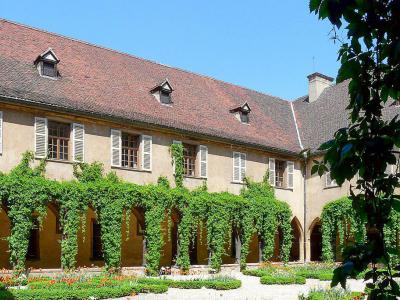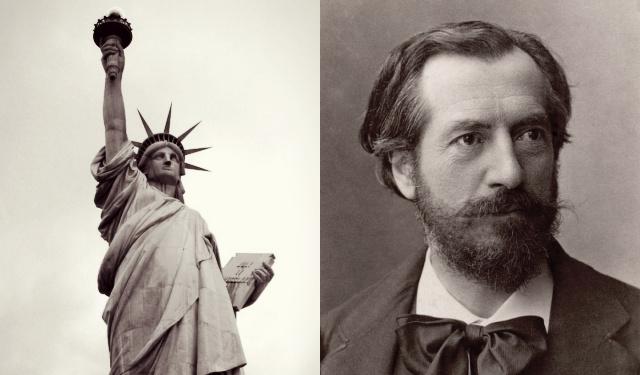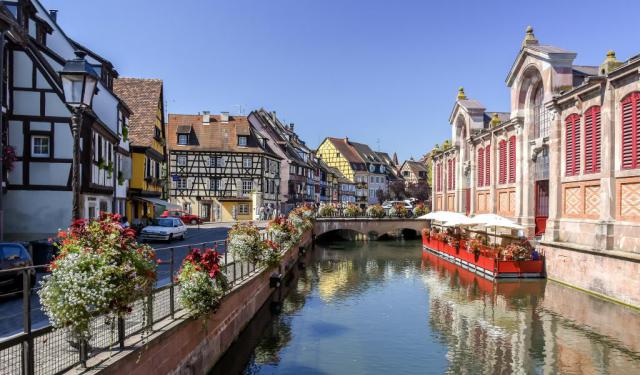
Couvent des Dominicains de Colmar (Dominican Church), Colmar
Also called the Dominican Church, the convent is located at the Dominican Square (Place des Dominicains) and Nr. 1 Martyrs-of-the-Resistance Square (Place des Martyrs-de-la-Resistance) in Colmar. Couvent des Dominicains de Colmar was built in 1289 by the Dominican mendicant order of Preachers. The Preachers had arrived in Colmar in 1260.
The church has a vaulted choir of five bays. It has an apse of five octagonal sides and a nave with six bays supported by slender columns without capitals. Its stained glass windows date from early in the 14th century. They depict scenes from the Life of Christ. The cloister has arcades established in an irregular rectangle.
The choir is earlier than 1300. The nave was completed in 1346. The "Virgin of the Rose Bush," an altarpiece painted in 1473 by Renaissance artist Martin Schongauer, is in the choir. Murals in the cloister, painted from the last days of the 15th century, show the Passion of Christ.
During the 19th century, the church served non-religious purposes. The church was used for military stores during the French Revolution. In 1807 it became a corn exchange. In 1898 it was returned as a place of worship.
The convent buildings were erected in 1300, rebuilt in the 18th century, transformed into barracks for the gendarmerie in 1795, then housed the preparatory school for teachers. Since 1951 they have accommodated the municipal library.
The cloister and the church have been classified as historical monuments since November 2, 1948.
The church has a vaulted choir of five bays. It has an apse of five octagonal sides and a nave with six bays supported by slender columns without capitals. Its stained glass windows date from early in the 14th century. They depict scenes from the Life of Christ. The cloister has arcades established in an irregular rectangle.
The choir is earlier than 1300. The nave was completed in 1346. The "Virgin of the Rose Bush," an altarpiece painted in 1473 by Renaissance artist Martin Schongauer, is in the choir. Murals in the cloister, painted from the last days of the 15th century, show the Passion of Christ.
During the 19th century, the church served non-religious purposes. The church was used for military stores during the French Revolution. In 1807 it became a corn exchange. In 1898 it was returned as a place of worship.
The convent buildings were erected in 1300, rebuilt in the 18th century, transformed into barracks for the gendarmerie in 1795, then housed the preparatory school for teachers. Since 1951 they have accommodated the municipal library.
The cloister and the church have been classified as historical monuments since November 2, 1948.
Want to visit this sight? Check out these Self-Guided Walking Tours in Colmar. Alternatively, you can download the mobile app "GPSmyCity: Walks in 1K+ Cities" from Apple App Store or Google Play Store. The app turns your mobile device to a personal tour guide and it works offline, so no data plan is needed when traveling abroad.
Couvent des Dominicains de Colmar (Dominican Church) on Map
Sight Name: Couvent des Dominicains de Colmar (Dominican Church)
Sight Location: Colmar, France (See walking tours in Colmar)
Sight Type: Religious
Guide(s) Containing This Sight:
Sight Location: Colmar, France (See walking tours in Colmar)
Sight Type: Religious
Guide(s) Containing This Sight:
Walking Tours in Colmar, France
Create Your Own Walk in Colmar
Creating your own self-guided walk in Colmar is easy and fun. Choose the city attractions that you want to see and a walk route map will be created just for you. You can even set your hotel as the start point of the walk.
Bartholdi's Statues in Colmar
Auguste Bartholdi is one of the most famous artists from Colmar. His works, such as the Lion of Belfort in Belfort, France, and the Statue of Liberty in New York Harbor, are known around the world. Colmar is decorated with open-air pieces sculpted by the artist.
Many of Bartholdi's statues are found in fountains that occupy spaces in city squares or on significant street corners. Some of... view more
Tour Duration: 3 Hour(s)
Travel Distance: 5.9 Km or 3.7 Miles
Many of Bartholdi's statues are found in fountains that occupy spaces in city squares or on significant street corners. Some of... view more
Tour Duration: 3 Hour(s)
Travel Distance: 5.9 Km or 3.7 Miles
Colmar Introduction Walking Tour
Charlemagne was well acquainted with Colmar in his wars with the Saxons from 772 to 804 AD. Carolingian emperor Charles the Fat held an assembly there in 884. It was a free imperial city under Emperor Frederick II in 1226. Captured and held by Sweden in 1632, it was conquered at last by Louis XIV of France in 1673.
In 1871 it was annexed by the German Empire as a result of the Franco-Prussian... view more
Tour Duration: 1 Hour(s)
Travel Distance: 1.5 Km or 0.9 Miles
In 1871 it was annexed by the German Empire as a result of the Franco-Prussian... view more
Tour Duration: 1 Hour(s)
Travel Distance: 1.5 Km or 0.9 Miles


